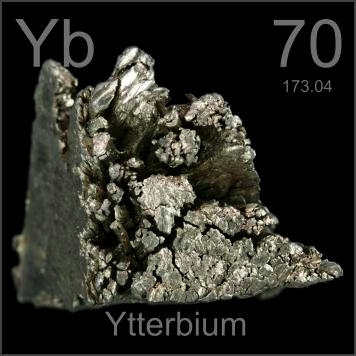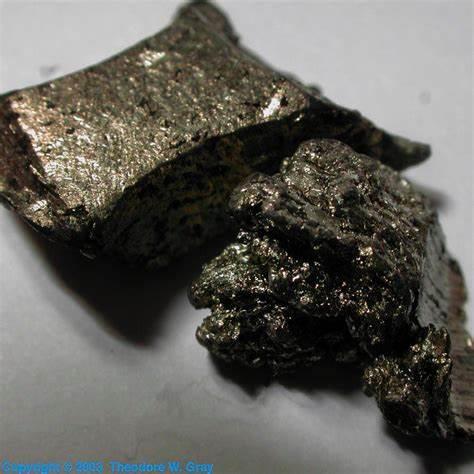The rare earth element ytterbium is a soft, malleable, and ductile element known for its bright silvery luster. Ytterbium is the fourteenth and penultimate element in the lanthanide series, an occurrence that explains the relative stability of its +2 oxidation state. But like the other lanthanides, the most common or stable oxidation state of Ytterbium is +3. Ytterbium is categorized as a rare-earth element, denoted by the symbol Yb, and has an atomic number of 70. The element is easily attacked and dissolved by mineral acids, but reacts slowly with water, and oxidizes in air. The oxide produced forms a protective layer on the surface of the compound. Compounds of ytterbium are typically rare in nature.

This element is obtainable in the oxide, halides, and other compounds of the element. Due to the closed-shell electron configuration of ytterbium, its density, melting, and boiling points differ significantly from those of most other lanthanides. Common applications of ytterbium include the production of allied and the enhancement of the mechanical properties of steel, such as grain refinement and strength of the alloy. Note that Ytterbium is the most volatile rare-earth metal known.
Further Reading: Seventeen Rare Earth Elements Introduction
Occurrence of Ytterbium in the Environment
Ytterbium is found alongside other rare-earth elements in several rare minerals, such as gadolinite, monazite, and xenotime. In its natural form, ytterbium is a combination of seven stable isotopes. The element is mostly mined in China, U.S., Brazil, and India in the form of the minerals monazite, euxenite, and xenotime. It is one of the least abundant rare-earth elements. It should be noted that ytterbium, after it’s been extracted and prepared, poses a health risk to humans, as it causes eye and skin irritation. In general, global production of ytterbium is around 50 tonnes per year.
Discovery of Rare Earth Ytterbium
The Swiss chemist, Jean Charles Galissard de Marignac was able to separate a rare-earth called ytterbia from the rare-earth erbia in 1878. Ytterbia is an independent component, named after Ytterby, the village in Sweden near where he found the new component of erbium. Jean Carles believed that ytterbia was a compound of a new element, which he called ytterbium. And it was not until 1953 that a relatively pure sample of the metal was not obtained.
Properties of Rare Earth Ytterbium
Here are important chemical and physical properties of ytterbium:
- Ytterbium is soft, malleable, and ductile with a bright silvery luster in its pure state.
- It readily dissolves in strong mineral acids and reacts slowly with cold water, while it oxidizes slowly in the air.
- Ytterbium has three allotropic forms, called alpha, beta and gamma. The alpha allotrope has a hexagonal crystalline structure and is stable at low temperatures. The beta allotrope exists at room temperature with a face-centered cubic crystal structure. Finally, the high-temperature gamma allotrope has a body-centered cubic crystalline structure.
- Ytterbium exhibits weak paramagnetism, and it has the lowest magnetic susceptibility of all the rare-earth metals.
- Ytterbium reacts well with all halogens.
- Mixtures of powdered ytterbium with polytetrafluoroethylene or hexachloroethane are known to burn with a luminous emerald-green flame.
- Ytterbium also reacts with hydrogen to yield different non-stoichiometric hydrides.
- This element is pretty electropositive. It reacts slowly with cold water and quickly with hot water to produce ytterbium(III) hydroxide.
- Naturally-occurring ytterbium comprises seven stable isotopes, which are: 168Yb, 170Yb, 171Yb, 172Yb, 173Yb, 174Yb, and 176Yb. 174Yb is the most common, but 27 radioisotopes of ytterbium have been observed, where the most stable ones are 169Yb, 175Yb, and 166Yb.

Applications of Rare Earth Ytterbium
Doping of stainless steel
Ytterbium is currently being used as a dopant for improving the grain refinement, strength, and other mechanical properties of stainless steel. Although rarely used, ytterbium alloys are also applicable in dentistry.
Thin-Film Coating
Ytterbium sputtering targets and ytterbium evaporation materials are used in deposition processes including semiconductor deposition, chemical vapor deposition (CVD) and physical vapor deposition (PVD).
Ion Qubits Used for Quantum Computing
The charged ion 171 Yb+ isotope has been used in trapped-ion qubits in quantum computing. Mølmer–Sørense and other entangling gates have been achieved by addressing the ions with mode-locked pulse lasers.
Source of gamma rays
The 169Yb isotope, which has a half-life of 32 days, obtained from neutron activation during the irradiation of ytterbium in nuclear reactors, has been demonstrated to be valuable as a source of radiation in portable X-ray machines.
High-stability atomic clocks
Ytterbium clocks are known for their stability with ticks. Note that clocks developed at the National Institute of Standards and Technology (NIST) rely on about 10,000 rare-earth atoms cooled to 10 microkelvins and trapped in an optical lattice — a series of pancake-shaped wells made of laser light.
Ytterbium as dopant of active media
The Yb3+ ion is also used as a doping material in active laser media. Examples are solid-state lasers and double-clad fiber lasers. Ytterbium lasers have been found to be very efficient, with a long lifespan, and are able to generate short pulses. Alternatively, ytterbium can be incorporated into materials used in making the laser.
Conclusion
Ytterbium is a soft, bright, and silvery rare-earth metal with an atomic number, of 70. It is the most volatile rare-earth element and occurs naturally with other rare-earth minerals. The element is popularly used to improve the mechanical properties of stainless steel and is also a dopant in active media, among other important applications. If you want to know more about rare earth elements, we would like to advise you to visit Stanford Advanced Materials (SAM) for more information.




